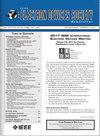High Power Added Efficiency Enhancement-Mode Γ-Gate RF HEMT With High/Low p-GaN Doping Profile
IF 2.4
3区 工程技术
Q3 ENGINEERING, ELECTRICAL & ELECTRONIC
引用次数: 0
Abstract
高功率附加效率增强模式Γ-Gate高/低p-GaN掺杂的RF HEMT
$0.5~\mu $ 研究了在p-GaN层中掺杂工程Mg谱线的m增强模式(e模式)p-GaN $\Gamma $门射频HEMT在高功率放大器中的应用。在p-GaN中采用高/低Mg掺杂设计,经过550℃3分钟的栅极退火后,传统的Ti/p-GaN肖特基栅极行为可以转变为欧姆栅极。p-GaN HEMT的欧姆栅极设计可以最大限度地减少池-峰峰(PF)发射,从而改善闪变噪声和电流崩溃(C.C)。由于低Mg ($1\times 10{^{{19}}}$ cm-3)掺杂浓度的p-GaN层具有陡峭的C-VG曲线,因此具有较好的门到通道调制能力。该器件的阈值电压(VTH)为+1.1 V,导通电阻(RON)低至$1.8~\Omega \cdot $ mm,断态击穿电压为206v。采用工程Mg掺杂剖面设计,70% PAE is achieved together with an output power density of 1W/mm at VDS of 10V.
本文章由计算机程序翻译,如有差异,请以英文原文为准。
求助全文
约1分钟内获得全文
求助全文
来源期刊

IEEE Journal of the Electron Devices Society
Biochemistry, Genetics and Molecular Biology-Biotechnology
CiteScore
5.20
自引率
4.30%
发文量
124
审稿时长
9 weeks
期刊介绍:
The IEEE Journal of the Electron Devices Society (J-EDS) is an open-access, fully electronic scientific journal publishing papers ranging from fundamental to applied research that are scientifically rigorous and relevant to electron devices. The J-EDS publishes original and significant contributions relating to the theory, modelling, design, performance, and reliability of electron and ion integrated circuit devices and interconnects, involving insulators, metals, organic materials, micro-plasmas, semiconductors, quantum-effect structures, vacuum devices, and emerging materials with applications in bioelectronics, biomedical electronics, computation, communications, displays, microelectromechanics, imaging, micro-actuators, nanodevices, optoelectronics, photovoltaics, power IC''s, and micro-sensors. Tutorial and review papers on these subjects are, also, published. And, occasionally special issues with a collection of papers on particular areas in more depth and breadth are, also, published. J-EDS publishes all papers that are judged to be technically valid and original.
 求助内容:
求助内容: 应助结果提醒方式:
应助结果提醒方式:


